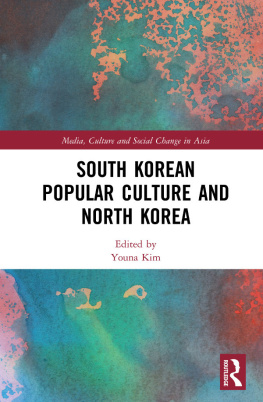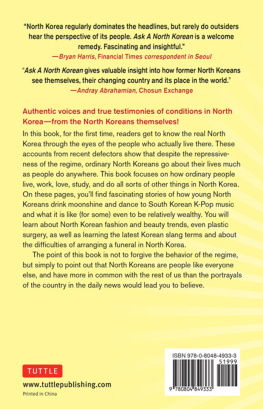Crisis in a Divided Korea
To Benjamin Robert Matray
Master Architect
Copyright 2016 by ABC-CLIO, LLC
All rights reserved. No part of this publication may be reproduced, stored in a retrieval system, or transmitted, in any form or by any means, electronic, mechanical, photocopying, recording, or otherwise, except for the inclusion of brief quotations in a review, without prior permission in writing from the publisher.
Library of Congress Cataloging-in-Publication Data
Names: Matray, James Irving, 1948 author.
Title: Crisis in a divided Korea : a chronology and reference guide / James I. Matray.
Description: Santa Barbara, California : ABC-CLIO, 2016. | Includes bibliographical references and index.
Identifiers: LCCN 2015043231 | ISBN 9781610699921 (hardback) | ISBN 9781610699938 (ebook)
Subjects: LCSH: Korean reunification question (1945) | KoreaHistory. | Korea (South)History. | Korea (North)History. | KoreaForeign relations. | Korea (South)Foreign relations. | Korea (North)Foreign relations.
Classification: LCC DS907.18 .M37 2016 | DDC 951.904dc23
LC record available at http://lccn.loc.gov/2015043231
ISBN: 978-1-61069-992-1
EISBN: 978-1-61069-993-8
201918171612345
This book is also available on the World Wide Web as an eBook.
Visit www.abc-clio.com for details.
ABC-CLIO
An Imprint of ABC-CLIO, LLC
ABC-CLIO, LLC
130 Cremona Drive, P.O. Box 1911
Santa Barbara, California 93116-1911
This book is printed on acid-free paper 
Manufactured in the United States of America
Portions of this book have been adapted and expanded from:
James I. Matray, Conflicts in Korea, in A Companion to Harry S. Truman, Daniel Margolies, ed. (Malden, MA: Blackwell-Wiley Publishers, 2012), 51112.
James I. Matray, The Failure of the Bush Administrations North Korea Policy: A Critical Analysis, International Journal of Korean Studies, Vol. XVII, No 1, Spring/Summer 2013, 140177.
Contents
On July 7, 1953, the Korean armistice agreement required that the belligerents move their troops back 2,000 meters from a mutually agreed-upon military line of contact, thereby creating a demilitarized zone (DMZ) 4 kilometers wide. Since that date, the DMZ has cut the Korean Peninsula roughly in half, crossing the 38th parallel on an angle, with its west end lying to the south and the east end to the north. A surprising outcome constitutes perhaps the only positive result of Koreas artificial division. Natural isolation of this band of land 155 miles in length has created an accidental nature preserve that environmentalists now recognize as one of the most protected areas of calm habitat in the world. Incredibly, many endangered animal and plant species thrive safely among the heavily fortified fences, landmines, and listening posts that dot the DMZ. Ecologists have identified as living in the buffer zone no less than 2,900 plant species, 70 types of mammals, and 320 kinds of birds. These include the very rare Korean tiger, Amur leopard, and Asiatic black bear, as well as migratory White-naped crane that stop over each spring and fall before wintering in Japan. Another elegant and prized visitor is the red-crowned Manchurian crane that for more than a thousand years has been a symbol of good luck, fidelity, and long life in East Asia.
Geography explains the varied biodiversity of the DMZ, which crosses mountains, prairies, swamps, lakes, and tidal marshes. But it has become a unique ecosystem because of the absence of human disturbance for over 60 years. Richly forested and unspoiled, migratory geese and wild ducks arrive in October from breeding grounds in northeastern China and Russia and leave during February. Amid a plethora of wildflowers, these birds cohabitate with other year-round residents in this verdant strip such as pheasant, wild pigs, and small Korean deer. Unlike the wildlife, humans likely could not detect the densely planted underground web of deadly land mines. They also would find threatening across the width of the peninsula the high fences of barbed and razor wire both north and south under the surveillance of more than a thousand guard posts, watchtowers, and reinforced bunkers. Fences and mines are absent in the DMZ only at the Joint Security Area in the clearing at Panmunjom. Conference buildings there are located atop the demarcation line with the arrangement of negotiation tables inside so that the dividing lines extend precisely down the middle. To say the least, the serenity of this nature sanctuary is deceptive.
Koreas DMZ exemplifies the precarious peace that Koreans have had to tolerate for more than a century, even after enduring 40 years of Japanese colonial exploitation and a 3-year war of colossal brutality. This book describes how a pattern of recurring crisis has dictated events in the course of Koreas tragic modern history. Padraic (Pat) Carlin, ABC-CLIO acquisitions editor for military history, deserves credit for conceiving this project and thanks for asking me to be its author. Michelle Scott, Gordon Hammy Matchado, Karen Morris, and the rest of his team have done an excellent job transforming a manuscript into a publishable book. Finally, I could not have completed this study or, for that matter, anything else of importance in my professional life without the constant and unfailing love and support of my dear wife Karin. Among all the gifts she has given to me, the most important are our children, Benjamin Robert and Amanda Jane. Benjamin thrives as the architect for Butte County, California, after bravely choosing a career other than that of his educator parents. His professionalism, attention to detail, and perseverance are just a few of the talents that have established his reputation as a master in his field. I am dedicating this book to Benjamin in thanks for being a son far exceeding any fathers expectations.
| ASEAN | Association of Southeast Asian Nations |
| CCP | Chinese Communist Party |
| CFC | Combined Forces Command |
| CPKI | Committee for the Preparation of Korean Independence |
| CPP | Choson Peoples Party |
| CPVF | Chinese Peoples Volunteers Force |
| CVID | complete, verifiable, irreversible dismantlement |
| DFUF | Democratic Front for the Unification of the Fatherland |
| DJP | Democratic Justice Party |
| DMZ | demilitarized zone |
| DNF | Democratic National Front |
| DNP | Democratic National Party |
| DPRK | Democratic Peoples Republic of Korea |
| DRP | Democratic Republican Party |
| GCC | Ground Component Command |
| GGK | Government General of Korea |
| GMD | Guomindang |
| GNP | Grand National Party |
| GNP | gross national product |
| GPCR | Great Proletarian Cultural Revolution |
| HEU | highly enriched uranium |
| IAEA | International Atomic Energy Agency |
| IMF | International Monetary Fund |
| JCS | Joint Chiefs of Staff |
| JSA | Joint Security Area |
| KCIA | Korean Central Intelligence Agency |
| KCP | Korean Communist Party |
| KDP | Korean Democratic Party |











